
 | ||||||
 |
|
Our MIDI line driver systems overcome the distance restriction (officially 15 metres maximum) of the standard MIDI hardware. They convey a MIDI datastream over long cable runs by converting to and from a robust differential (balanced) signal format. We make two types of long distance MIDI Line driver system, the widely-used high-performance MLD, and the useful bi-directional MTR.
 MLD MIDI Line Driver
MLD MIDI Line DriverMLD allows the signal to traverse cable runs of up to a kilometre with quality screened twisted pair (STP) cable. Unscreened cable can also be used.
![[Long Distance MIDI: MLD photo]](pix/mldphoto.jpg)
The MLD system consists of a pair of units. MLD/T is a transmitter unit with a built-in mains (ac) power supply and integral mains lead (ac power cord) fitted with a plug. A POWER lamp indicates that the MLD/T is powered-up. A DATA lamp flashes clearly to indicate that that MIDI data is passing through.
As with all our ac-powered products, versions are available for 110 V ac as well as 230 V ac. Power plugs for various international standards are also available.
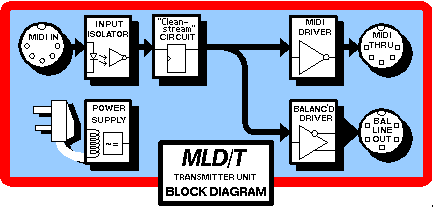
The MLD/R receiver unit is phantom-powered over the line. The case of each unit are 109mm x 55mm x 40mm. The connection to the line cable is via 240 degree 5 pin DIN plugs, which are supplied.
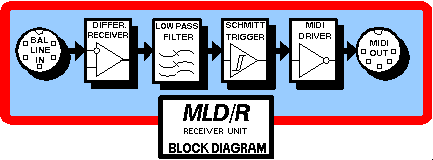
MIDI-thru chains can distort the MIDI waveforms. So that the line driver is sure to receive a clean signal, the MLD/T unit includes our fast, high -precision "Cleanstream" waveform restitution. This processing is applied to the MIDI-thru output and the line output. Because this processing ensures that the duty cycle of the waveform is perfect, it also helps to make sure that the MLD system can convey a signal over the full specified distance. The "Cleanstream" process has a 250ns sample period, so it is many times more discriminating than ordinary serial interfaces.
The differential LINE cable connections are made via 240 degree 5 pin DIN plugs and sockets.
In the receiver unit, a low pass filter followed by hysteresis provide amazingly reliable performance, even in electrically noisy environments. Hysteresis is the method where the threshold level of a signal detector changes depending on the previous state of the signal; it is employed to enhance noise immunity.
In live performance situations, the MLD can allow on-stage MIDI gear to be controlled from the desk. Alternatively, the MLD can transmit performance data back to modules located at the desk end.
MIDI-based systems installed in theatres may require the ability to get MIDI data down long cable runs reliably. The MLD system can do this.
This product information is also available in Adobe Acrobat .pdf format.
 MTR Bidirectional MIDI Line Driver
MTR Bidirectional MIDI Line DriverTheMTR MIDI Line Transmitter/Receiver offers a full duplex solution for MIDI communication over cable runs of up to 150m. This product does not feature waveform restitution.
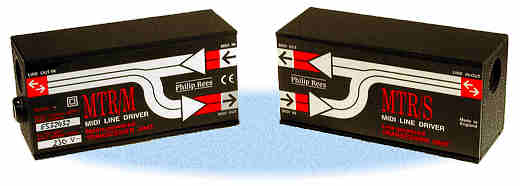
MTR consists of a pair of units, each of which is a dinky 109mm x 55mm x 40mm. The cable link between the two units is made via four or five conductors, two screened twisted pairs would be ideal. The connections to the line cable are via 240 degree 5 pin DIN plugs, which are supplied.
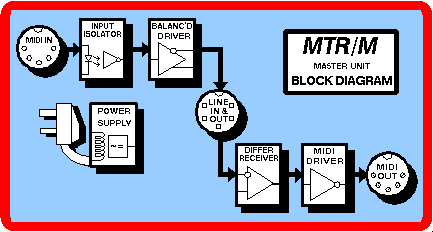
One unit is the mains-powered master transceiver, MTR/M. It has MIDI In, MIDI Out and Line connectors plus a captive mains lead supplied with a plug. There is an indicator to let you know that the unit is powered-up.
Versions of this unit are also available for both international ac voltage ranges.
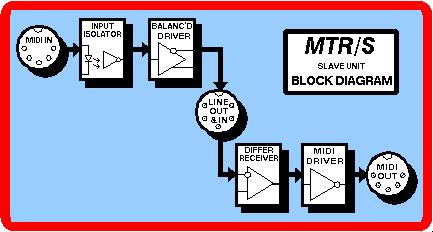
The second unit is the remote slave transceiver, MTR/S. This derives its power from the line. It has MIDI In, MIDI Out and Line connectors.
Remember, the MTR is particularly useful where no mains power is conveniently available at the remote end of the line.
In live music applications, the MTR can allow interaction between MIDI equipment on the stage and at the desk. The MTR can work down multicore and has many uses in live sequencing and automation.
MIDI-based show control systems may be installed in theatres. For example, MIDI may be used to control lighting or to transfer triggers from the stage to automatically cue sound effects. These situations require the ability to get MIDI data down long cable runs.
In recording studios, particularly with remotely located control rooms, an MTR system can be part of the permanent installation. They can also be used on an ad hoc basis, with the remote unit employed rather like a DI box.
As normal, the MLD and MTR systems use regular 180° five-pin DIN connections for their conventional MIDI ports. In order to avoid inadvertent connection to standard MIDI ports, they use different connectors for their LINE ports. For the LINE connections, 240° (also known as 60°) five-pin DIN sockets are used. Our line driver systems are shipped with a pair of suitable 240° DIN plugs. Although the same kind of connectors are used for the two Line Driver systems, the MTR uses different pin assignments from the MLD. Cables for both units should be wired pin-to-pin (that is, pin1-to-pin1, pin2 to pin2, and so on). Unlike 180° DIN connectors, the pins of the 240° DIN plug are numbered in order, anti-clockwise as viewed from the mating side of the socket (solder side of male plug).
Note: ° is a degree sign.

The connections to pins 4 and 5 in the MTR cable are also required to supply power to the MTR/S unit from the MTR/M.
![]() You may need to download the Acrobat Reader free from the Adobe site in order to view or print .pdf documents.
You may need to download the Acrobat Reader free from the Adobe site in order to view or print .pdf documents.![]() The MLD and MTR info is also available as an Acrobat .pdf file - size: 280k bytes.
The MLD and MTR info is also available as an Acrobat .pdf file - size: 280k bytes.

![]() to Phil Rees Music Tech home page
to Phil Rees Music Tech home page
![]() to Phil Rees Music Computers division index page
to Phil Rees Music Computers division index page
![]() to Phil Rees MIDI division index page
to Phil Rees MIDI division index page